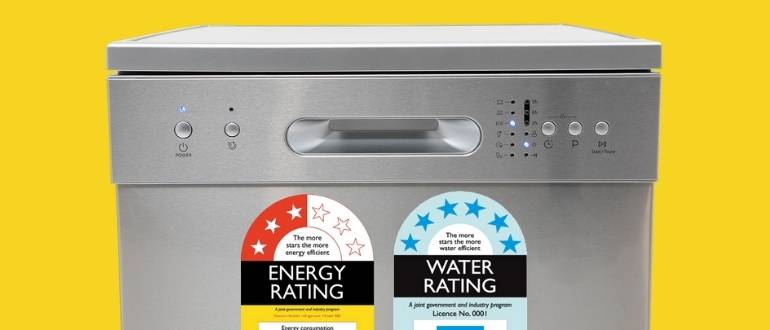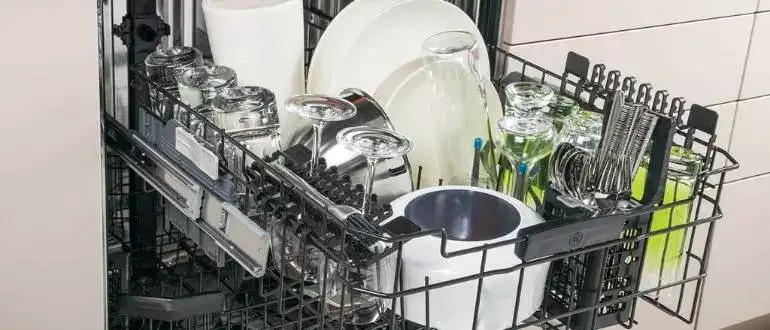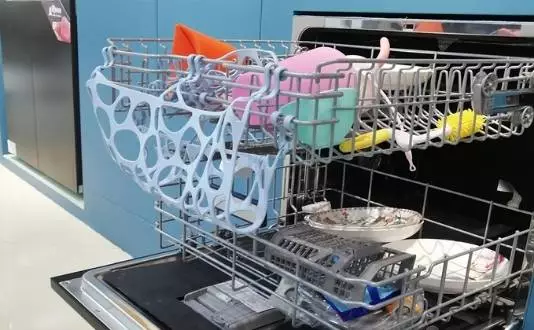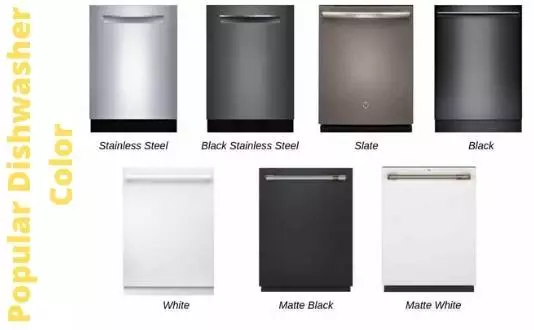It’s a question that many people have pondered: what to look for when buying a dishwasher? The answer is complicated, as there are so many different types of dishwashers to choose from.
Do you want something with stainless steel exterior or an interior? Built-in or portable?
If the latter, do you need it to be electrical and self-contained (i.e., does it include its own water reservoir)?
What about features like adjustable racks and height settings? How important are these to you? You’ll also need to decide if affordability is your top priority.
There are also other features that might not seem like a big deal but could make life easier when loading and unloading dishes.
I’ll go over 31 things below that you should consider before buying your next dishwasher!

31 Things You Should Consider Before Buying A Dishwasher:
- Dishwasher Types
- Energy Efficiency
- Number of Place Settings
- Loading Style
- Noise Level
- Capacity to Handle Large Loads
- Delay Start
- Number of Wash Cycles
- Dishwasher Features
- Price Range
- Interior Finish (Stainless Steel or Plastic)
- Dishwasher Options (Cup Shelves, Cutlery Basket, Etc.)
- Cycle Time
- Water Conservation Ability
- Installation Options
- Detergent Dispenser Type
- Customizable Interior Rack Capacity
- Dishwasher-Safe Items (Plastics, Silverware)
- Child Safety
- Materials Production
- Finish (Color)
- Cleaning Performance
- Controls & Settings
- Additional Features (I.e., 3rd Rack, Water Jet Spray, Etc.)
- Additional Cycle Options
- Additional Vent Requirements
- Number & Size of Racks/compartments
- Warranty Length
- Dishwasher Dimensions
- Dishwasher Height
- Dishwasher Weight
Now we will discuss each of these points in detail.
1. Dishwasher Types
Before buying a dishwasher you should consider what types of dishwasher you need.

I. Integrated Dishwasher
These dishwashers are built directly underneath the countertop and will completely disappear into your kitchen design.
In order to provide a perfect uniformity, these dishwashers should be bought with the same kind of cabinets, countertops and sink as they will look like they were built together from the beginning.
II. Freestanding Dishwasher
This type of dishwasher is generally bigger than the integrated dishwasher and it’s placed in a place without a cabinet or a countertop beneath it.
This kind of dishwasher can be moved easily if you want to rearrange your kitchen but ensure you have enough room for its size before buying one.
The price range varies depending on their brand, design and types but generally is more expensive than the integrated one.
III. Portable Dishwasher
It is not usual to find portable dishwashers in many homes but they can be very useful when you want to do your dishes on the go or in several locations around your home.
They are used mostly by campers and RV owners because of their mobility and they are fairly inexpensive compare to the above two types.
IV. Undercounter Dishwasher
This kind of dishwasher is perfect for homes that have limited space, houses with a small kitchen design or little budget because this type has a smaller size compared to other dishwashers.
It’s usually installed beneath the countertop which makes them easy to use and accessible although they mostly will require plumbing connections for their water supply.
V. Countertop Dishwasher
Countertop dishwashers are perfect for apartment owners, small family homes or homes that have little budget because of their size. They can be placed anywhere on your countertops without having an effect on the rest of your suite.
They come with a few dish racks and some models include cutleries tray too.
They’re usually more affordable than other types but require to be plugged into an electrical outlet all the time which makes them less efficient than other types of dishwashers.
VI. Freestanding-Undercounter Dishwasher
This type of dishwasher is more versatile compared to others since it combines some features from both integrated and under-counter dishwashers.
It’s great if you want it to be a permanent fixture but also want to have a more accessible dishwasher.
VII. Built-In Dishwasher
Built-in dishwashers are designed for you who want a perfect kitchen design with everything built together from the beginning.
They can be installed into an existing space within your kitchen cabinet or if the space is available, they can also replace your cabinets and countertop too.
It will provide a seamless look. The problem using this kind of dishwasher is that it’s very hard to upgrade them as your family needs change since they’re built right at the spot and part of your kitchen design like flooring and paint colors, make sure you really need one before buying it.
VIII. Integrated Dishwasher Drawer
This type of dishwasher is built underneath your sink cabinet which makes it’s perfect for homes with limited space.
They are designed especially to save more space for you and they will also fit perfectly into your kitchen design.
These dishwashers require plumbing connections but some models don’t need an electrical connection too.
IX. Portable Dishwasher Drawer
As the name suggests, this kind of dishwasher drawer can be moved easily around your home without any problems.
You can even take it with you when you go camping or on a picnic outside.
The downside about this dishwasher drawer is that they’re usually smaller than other types of portable dishwashers.
Some models include only one rack whereas other has two racks inside them.
X. Outdoor Dishwasher
This is the last type of dishwasher you can find on the market which is perfect if you’re planning to remodel your outdoor kitchen.
They only come with two standard racks inside them but they are designed to withstand extreme weather conditions so don’t worry about it being stolen or rusting after a long time of use.
2. Energy Efficiency
If you’re looking for a dishwasher, then energy efficiency should be one of your top concerns.
First off, look at the Energy Star label and see what kind of an energy rating the dishwasher has.

How does it compare? The more stars a dishwasher has, the more efficient its water and energy usage is.
But this doesn’t mean that a system with fewer stars will not get your dishes clean or won’t last as long!
You just have to pay attention to how much water each cycle uses and if it includes features like half-load cycles to help reduce energy use when possible.
3. Number of Place Settings
Sometimes listed as capacity, the number of place settings refers to how many dishes the appliance can hold at one time.
The options range from 6-14 place settings so you should consider your household’s size before making a purchase!
Portable dishwashers are usually rated for 9-10 places while built-in models can fit around 12-16 plates. Just keep in mind that some large items might not be included.
Furthermore, if you have a smaller family or don’t mind doing laundry more often, you might want to consider purchasing a compact dishwasher with 5 place settings instead of something larger which holds 8 places.
4. Loading Style
The interior of many dishwashers is either standard or stemware style.

Standard-load dishwashers are more common and better for most homes because they’re flexible and prevent water from spilling out (stemware-style loads run the risk of getting water everywhere).
Stemware-style comes in handy if you like serving champagne glasses on special occasions! But keep in mind that style is not conducive to silverware organization, so you may want to choose standard over stemware.
5. Noise Level
Some dishwashers are super quiet, but most models make some noise. However, if you don’t mind some noise then check out models with stainless steel tubs or insulation which can reduce decibel levels by 5-10dBA!
This means that your dishwasher will still get the job done even if it’s located inside your bedroom (unless of course, nobody can sleep through loud noises!)
6. Capacity to Handle Large Loads
This factor depends on how much your family uses dishes. If you have a big group, then it’s best to get one with a higher capacity to prevent regular loads from occurring.
But if you live alone or in a small household, opt for a less expensive dishwasher that still gets the job done!
7. Delay Start
You can find this feature in many modern dishwashers and it’s definitely worth getting.
A delay start allows you to program the machine so that an entire load will run later at night or when nobody is home during the day – maybe while you’re sleeping or at work?
This is extremely useful because everybody has busy schedules and nobody wants their clean plates smelling like dirty plates ever again!
With a delayed start, you won’t have to keep the dishwasher open all night or for hours on end.
8. Number of Wash Cycles

Most models come with three different cycles: normal, intensive, and normal/eco mode.
The normal cycle is most commonly used and what you see in terms of wash time will depend on how dirty your dishes are (the more food stuck on, the longer it takes).
Intensive mode gets your dishes extra-clean if they’re heavily soiled. But this also eats up energy plus water.
Normal/eco simply uses less water during the first two stages of washing – it’s best if you don’t plan on reusing plastic utensils or need your dishes extra-clean at every use!
9. Dishwasher Features
This is an important factor to consider when buying a dishwasher! Many machines come with special features like the ability to add steam or intelligence (like many models from Bosch).
These add-ons vary in price and you’ll need to make sure they’re worth it for your specific needs.
For example, if you’ve got kids who tend to leave their silverware out on countertops then adding a sounder can be useful.
That way you don’t get annoyed every time somebody doesn’t put away their dishes and the machine turns on automatically!
10. Price Range
$500 to $1000 – good basic dishwasher
$1000 to $1500 – mid-range dishwashers with quieter sound levels and increased washability.
$1500 to above – Over $1500 will get you a high end, quiet dishwasher. This price will also give you more options for customizing the dishwashing experience.
11. Interior Finish (Stainless Steel or Plastic)
Both types of interior finishes can be cleaned easily and they’re both designed to not stain or retain food residue.
However, the plastic finish is easier to scratch while cleaning; you’ll need to place any sharp utensils in a separate compartment if this concerns you.
12. Dishwasher Options (Cup Shelves, Cutlery Basket, etc.)

Many models are already equipped with cup shelves but they don’t all offer them at the same price point.
As an example, some machines have removable baskets while others include racks that are fixed into place.
This feature depends on your needs so look at reviews online before you make a purchase!
13. Cycle Time
The time it takes for a dishwasher to clean your dishes depends on the cycle you select, how dirty your dishes are, and whether or not you’ve pre-rinsed them.
When comparing two different models, always go with the faster one if it’s going to be used often – this will save water and energy over time!
14. Water Conservation Ability
Look out for Energy Star labels as appliances that have been tested by the EPA waste less water during their cleaning process.
Plus those units which use an eco-cycle can cut down water usage from 40 gallons per load to just 1 gallon! These may cost more up front but they will save money in the long run.
15. Installation Options

You can choose between a built-in or portable dishwasher.
The first option is usually installed beneath existing countertops, while the latter offers more flexibility in terms of placement within the kitchen.
Built-in units are often better at saving energy due to their well-sealed doors which prevent steam from escaping outside the kitchen.
They tend to cost more but they also require less maintenance overall!
16. Detergent Dispenser Types
i. Dishwasher-integrated detergent dispensers are built into the door of each dishwasher compartment.
They allow you to use liquid or powder detergents straight from a tube and they’re a great choice if your family loves all sorts of different flavors!
There’s no need to purchase a separate dispenser for this messy job, but you’ll have to clean the small opening on a regular basis so it doesn’t clog up with residue.
ii. Optional stand-alone soap/rinse dispensers come in two types: those that require pre-measuring your powdered or liquid detergents, and those that have rinse agent capsules inside them which just need to be snapped into place before each cycle runs.
The latter option is great for renters since you won’t have to worry about accidentally spilling food down the drain.
17. Customizable Interior Rack Capacity
Look out for adjustable racks that can be rearranged depending on what kind of load you need to wash.
Some dishes are flat but others have bulky lids. So it’s best to choose a model which can adapt accordingly!
If this is not possible, check the size of your largest plates/bowls before purchasing.
18. Dishwasher-safe items (dishware, plastics, silverware)
Some dishwashers are only recommended for certain materials whereas others can clean all sorts of upholstery.
This means there’s no need to double-check every time you load the dishwasher! Make sure to research this feature before purchasing or using your new appliance in order to avoid damage or accidental harm!
19. Child Safety
If you have children, look for dishwashers with safety sensors to prevent them from being injured by the moving parts.
Also, this prevents small children from opening the door while the machine is running.
20. Materials Production
Before buying a dishwasher, check what materials were used to create it. While most of the body is usually made out of stainless steel or plastic, some manufacturers also use carbon metal or wood in order to reduce costs.
But these components are often more flimsy and require regular maintenance. There’s no need to buy a dishwasher which requires extra work from you so look for appliances that come with a minimal amount of features!
21. Finish (Color)

Just like appliances, dishwashers come in a variety of colors so you can choose the one which best suits your kitchen’s current decor! Some models are only available in black or white but others also include stainless steel finishes for an extra sleek look.
22. Cleaning Performance
Once you’ve narrowed down your options, it’s time to look at their cleaning capabilities.
Check the manufacturer’s manual for water usage and energy ratings since appliances with more efficient (and expensive) parts usually require less water and electrical power in order to get the job done.
23. Controls & Settings
Different dishwashers include different control panels – some have fewer features while others allow customization depending on the type of load you’re running!
If possible, we recommend testing multiple models before purchasing one to make sure that all of its features work properly and that they’re easy to use.
Otherwise, you might end up with a dishwasher which requires lots of tinkering or fails to wash dishes by the time you install it!
24. Additional Features (i.e., 3rd rack, water jet spray, etc.)
Some dishwashers include special racks for silverware or specific dish compartments which allow you to separate certain items.
If you need additional space for large plates or bulky pots and pans, look for adjustable racks or multiple tines (spikes) which can hold odd-shaped dishes more efficiently!
Additional features can be useful but remember that they usually come with additional costs so only buy the ones that will help your cleaning process go by faster!
25. Additional Cycle Options
Some dishwashers offer separate options for specific loads. If you host many dinner parties, look for racks which can hold tall glasses or extra-large dinner plates in order to make sure your evening goes off without a hitch!
For homes with children, you might want to consider purchasing appliances with an additional cycle designed for baby bottles. These are usually self-explanatory since most models include only one or two settings!
26. Additional Vent Requirements
Since a dishwasher requires a vent to release hot air and steam, be sure that your kitchen features the necessary plumbing in order to properly install it.
Professional installation is usually needed for appliances larger than 24 inches but you can easily DIY if you’re installing a compact model!
To avoid dangerous leaks, all dishwashers require an anti-vibration or level mounting kit so make sure that your countertop provides support for the appliance before considering buying it!
27. Number & Size of Racks/Compartments
Although they might seem straightforward, carefully looking at the number and size of dishes you plan on washing each day will help narrow down your options.
Generally speaking, standard dishwashers usually have one main rack with two or three compartments to hold smaller dishes or silverware while specialty models have extra features such as a third rack or adjustable tines.
If you have large items which don’t fit in a standard dishwasher, look for a model with a bottom tray which can hold up to 11 inches of plates!
28. Warranty Length
The average warranty for dishwashers is around 1-2 years but some appliances can last even longer!
Many manufacturers offer an additional warranty which covers the cost of repairs if your appliance breaks down within a specific time frame.
You should also keep in mind that more expensive dishwashers usually include better parts meaning they might have a longer lifespan than modestly priced models!
29. Dishwasher Dimensions
For smaller kitchens, the dishwasher’s dimensions are very important since these appliances can take up a lot of space.
If you’re installing it under your sink, measure the width and height of your countertop to be sure that the appliance is neither too narrow nor too tall!
If you want to install it on top of your counter, look for racks which fold flat or shelves which slide underneath one another in order to make more room for taller dishes!
30. Dishwasher Height (i.e., Countertop vs Built-in)
Some homeowners prefer semi-portable dishwashers which don’t require professional installation.
These appliances can usually fit underneath most standard counters but they don’t always work with all cabinets.
Built-in dishwashers, on the other hand, are usually installed either at the very back of your kitchen’s countertop or inside a cabinet down below.
They’re more powerful and sometimes even have better features than portable models but they’re also more expensive since the installation costs money!
31. Dishwasher Weight
If you’re looking for a lightweight dishwasher, check out models which use plastic racks instead of metal ones!
In general, portable dishwashers usually have a weight limit of around 50 lbs.
So they can be moved from one room to the next without too many problems. Built-in models are a little heavier but even top-load dishwashers can often hold over 20 lbs.
What are the 3 most important things you want from dishwashers?
Top three features the most important things to me would be:
- The ability to clean dirty dishes;
- Low noise level;
- Efficient water usage.
FAQs About What To Look For In A Dishwasher?
1. What Is The Dishwasher’s Capacity – How Many Dishes Can It Hold At Once?
Most household dishwashers can hold 7-10 place settings (14 for the really big models).
The standard upper rack will hold 6 “soup” or dinner plates side-by-side. However, it’s possible to load 12 in if you use all available space.
2. How Much Water Does A Dishwasher Use?
Most dishwashers use between 6 and 16 gallons of water per entire cycle.
3. How Much Electricity Does It Use?
A standard dishwasher that is Energy Star qualified uses about 3 kWh of energy each load.
A traditional machine uses an average of 4-7 kWh/load which can add up to hundreds of dollars a year depending on how often you use it.
4. How Long Does A Dishwasher Cycle Take?
Most standard dishwasher cycles last about 2 hours.
5. Are There Special Installation Requirements?
Because of the electrical and water connections, you may need to hire an electrician and plumber to install your new dishwasher.
However, hooking up a portable dishwasher is as simple as plugging it in and connecting a hose to the sink.
6. What Are The Different Types Of Dishwashers?
There are 3 main types of dishwashers: portable, built-in and countertop models, which vary primarily in their installation requirements.
7. How Much Noise Does It Make?
Dishwashers are 40-50 dB during operation. City water supplies that have high sulfur content can increase this noise level.
8. Is There A Delay Start Timer For When You Want To Wash Your Dishes?
Most dishwashers offer delay start timers so you can set your machine to run only when the water is at an optimal temperature.
9. Are There Any Water Softening Features?
Some models have salt or rinse aid reservoirs to soften the hard-water supply where you live. Check with customer service before buying if you don’t know what type of water you have.
10. How Many Racks Are Available On The Dishwasher?
Most newer models have 2 upper and lower racks. One of the upper racks is usually adjustable to accommodate larger plates or odd-shaped items.
11. Can I Adjust The Height Of The Upper Rack?
Yes, some upper racks adjust in multiple ways so you can fit large pots and pans anywhere on the rack rather than having them overlap each other on a single row.
Final Words
A dishwasher is an essential appliance for any home. Choosing the right one can seem like a daunting task, but luckily we’re here to help!
We’ve put together this handy guide of things you should look out for when deciding on your next purchase.
The GE GDT730SSFSS 24″ Freestanding Dishwasher is an excellent dishwasher for your home.
It has a stainless steel exterior, which will look great in any kitchen and the silverware basket has enough room to fit all of your dishes without any hassle.
If you’re looking for a stylish appliance that cleans well while not breaking the bank then this should be at the top of your list!

